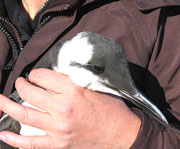Untitled Document
 |
An emaciated murre is found
on the beach near Seward, Alaska. |
SEATTLE (AP) — With a record number of dead seabirds washing up on West
Coast beaches from Central California to British Columbia, marine biologists are
raising the alarm about rising ocean temperatures and dwindling plankton populations.
"Something big is going on out there," said Julia Parrish, an associate
professor in the School of Aquatic Fisheries and Sciences at the University of
Washington. "I'm left with no obvious smoking gun, but birds are a good signal
because they feed high up on the food chain."
Coastal ocean temperatures are 2 to 5 degrees above normal, which may be related
to a lack of updwelling, in which cold, nutrient-rich water is brought to the
surface.
Updwelling is fueled by northerly winds that sweep out near-shore waters and
bring cold water to the surface. The process starts the marine food chain, fueling
algae and shrimplike krill populations that feed small fish, which then provide
a source of food for a variety of sea life from salmon to sea birds and marine
mammals.
On Washington beaches, bird surveyors in May typically find an average of one
dead Brandt's cormorant every 34 miles of beach. This year, cormorant deaths
averaged one every eight-tenths of a mile, according to data gathered by volunteers
with the Coastal Observation and Seabird Survey Team, which Parrish has directed
since 2000.
"This is somewhere between five and 10 times the highest number of bird
deaths we've seen before," she said, adding that she expected June figures
to show a similar trend.
This spring's cool, wet weather brought southwesterly wind to coastal areas
and very little northerly wind, said Nathan Mantua, a research scientist with
the Climate Impacts Group at the University of Washington. Without northerly
winds, there is no updwelling and plankton stay at lower depths.
"In 50 years, this has never happened," said Bill Peterson, an oceanographer
with the National Oceanic and Atmospheric Administration in Newport, Ore. "If
this continues, we will have a food chain that is basically impoverished from
the very lowest levels."
Problems at the bottom of the food chain could also be related to decreases
in juvenile salmon populations this summer.
NOAA's June and July surveys of juvenile salmon off the coasts of Oregon, Washington
and British Columbia indicate a 20% to 30% drop in populations, compared with
surveys from 1998-2004.
"We don't really know that this will cause bad returns. The runs this
year haven't been horrible, but below average," said Ed Casillas, program
manager of Estuarine and Ocean Ecology at NOAA's Northwest Fisheries Science
Center in Seattle.
Scientists tracking anomolies along Washington's coast reported the appearance
of warm-water plankton species and scores of jellyfish piling up on beaches.
A Guadalupe fur seal, native to South America, was found dead in Ocean Shores.
Parrish and a scientist near San Francisco report changes in bird breeding.
Both said starvation stress could be the cause for decreased breeding and increased
bird deaths.
Peterson, the NOAA oceanographer, said many scientists suspect climate change
may be involved.
"People have to realize that things are connected — the state of
coastal temperatures and plankton populations are connected to larger issues
like Pacific salmon populations," he said.
Parrish cautioned that human activity could jeopardize the survival of animals
already stressed by environmental changes.
"This, for instance, would be a truly bad year for an oil spill,"
she said.

